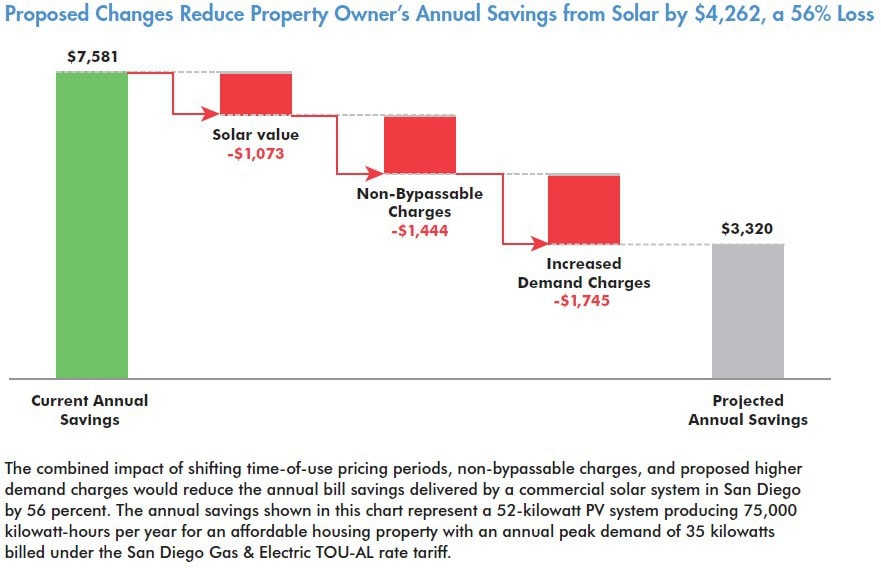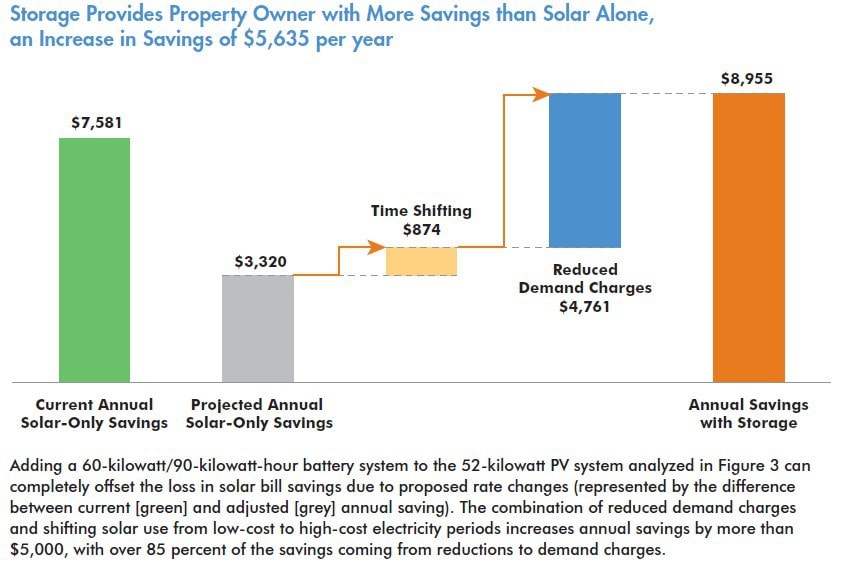May 31, 2017
Minimizing Solar Risk with Energy Storage
By Seth Mullendore
Impending changes to net metering policies and utility rates could drastically reduce the value of solar bill savings for commercial ratepayers in California. For affordable housing properties, the changes could translate into a 50 percent loss in solar savings.
That’s the bad news. The good news is that, by incorporating energy storage, those losses could be completely reversed – with the potential to deliver significantly greater savings than solar alone.
In a new paper, Solar Risk: How Energy Storage Can Preserve Solar Savings in California Affordable Housing, Clean Energy Group explores how these changes could affect affordable housing in the state. The paper walks through an analysis of an actual 50-unit affordable housing property under a rate tariff that would be widely applicable to medium- to larger-sized commercial properties in the San Diego area, including many affordable housing properties. It also looks at the potential role of energy storage minimizing the negative impact of these solar regulatory risks.
This type solar value deflation is a problem that goes beyond California. The current solar landscape is in flux in many states, adding risk and uncertainty to solar investment decisions. It is an unfortunate reality that, as more and more solar comes online, the grid, and how it is paid for, must inevitably evolve to meet the changing dynamics of supply and demand, often in ways that reduce the value proposition for distributed solar systems. This scenario is now being played out in California.
Three policy and utility rate changes being rolled out in the state will have a significant impact on solar bill savings for commercial properties: (1) peak electricity pricing periods (when electricity costs are highest) are shifting later in the day; (2) additional charges, called non-bypassable charges, are being applied to exported solar energy under net metering, and (3) utilities are increasing their demand charges.
As can be seen in the figure below, the combined impact of the three changes should give affordable housing owners and California policymakers something to think about. The property would see a 56 percent reducing in the electric bill savings delivered by its solar system, dropping from $7,581 per year to $3,320. Such dramatic losses could jeopardize the economic feasibility of new and existing solar projects installed in multifamily affordable housing properties across the state.
The most significant factor in this erosion of solar value is a proposed increase in utility demand charges, which accounts for more than 40 percent of the total loss in bill savings. Increases to per kilowatt demand charges in California, and many other markets, have significantly out-paced increases to per kilowatt-hour electricity usage charges. Because one cloudy day could erase any demand reduction savings a solar system might achieve throughout a month, this utility cost-shift from consumption to demand charges can be particularly damaging to the economics of solar investments.
Energy storage, on the other hand, is quite good at tackling demand. With the ability to effectively reduce demand, and, to lesser extent, shift solar energy use from periods of lower electricity pricing to periods of higher pricing, storage can reverse the anticipated losses to solar value. Adding a battery to the same 50-unit property, results in a $5,635 increase in annual savings, for a total of about $9,000 in bill savings each year. That’s more than the savings a solar-only system could achieve even before implementation of changes to net metering and rates.
In some cases, energy storage could reduce demand enough to enable a property to switch to a utility rate tariff without demand charges. This type of tariff switch could unlock even greater bill savings. For the San Diego property analyzed, annual bill savings would jump to nearly $28,000 under this scenario. That’s more than eight times what a solar-only system could achieve under the new regulatory conditions.
Such dramatic findings should serve as a wake-up call not only to affordable housing owners, but to California policymakers as well. The results should be taken into consideration when designing incentive programs aimed at advancing clean energy deployment in California’s low-income communities.
In the paper, Clean Energy Group recommends that policymakers conduct a broader survey to assess the extent of negative impacts on low-income communities and identify and address barriers to the adoption of integrated clean energy solutions for affordable housing.
As the country’s leading solar state, California is often a harbinger of changes in store for the larger solar landscape. According to the 2016 50 States of Solar Report, more than half of U.S. states reevaluated or adjusted net metering policies last year, and utilities have been increasingly shifting towards time-of-use rates and introducing or increasing demand charges, even for residential customers. While these shifts may challenge current solar business models, they also open new opportunities to deploy more integrated energy investments that support a smarter and more flexible electric power system.
Incentivizing integrated solar and storage solutions, for housing properties and other solar customers, will promote investments that are more financially sustainable over time, and that can adjust and adapt to changing grid dynamics. This would lead to outcomes that are beneficial to both customers and the grid.
The paper’s findings point to one simple fact: the future of solar is storage.
***
On Thursday, June 15, Clean Energy Group is hosting a webinar with report authors Seth Mullendore and Wayne Waite to discuss their findings. They will be joined by Stephanie Chen of the Greenlining Institute, who will discuss the broader impact of these changes on California’s low-income communities. A recording of this webinar will be posted here.
This blog post was also published in Renewable Energy World.
















